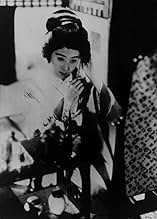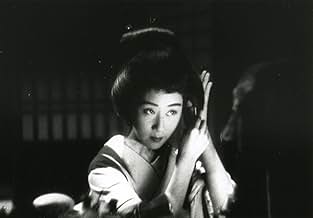AVALIAÇÃO DA IMDb
7,4/10
3,2 mil
SUA AVALIAÇÃO
Adicionar um enredo no seu idiomaTwo geisha sisters lead a hard life in the Gion district of Kyoto. After one of them feels obliged to support a bankrupt businessman, the other sister sets up various schemes to get rid of h... Ler tudoTwo geisha sisters lead a hard life in the Gion district of Kyoto. After one of them feels obliged to support a bankrupt businessman, the other sister sets up various schemes to get rid of him.Two geisha sisters lead a hard life in the Gion district of Kyoto. After one of them feels obliged to support a bankrupt businessman, the other sister sets up various schemes to get rid of him.
- Direção
- Roteiristas
- Artistas
- Prêmios
- 1 vitória no total
Namiko Kawashima
- Oemi Furusawa
- (as Kazuko Kuno)
Fumio Ôkura
- Jurakudo, the antiques dealer
- (as Fumio Okura)
- Direção
- Roteiristas
- Elenco e equipe completos
- Produção, bilheteria e muito mais no IMDbPro
Avaliações em destaque
This film is about geishas on Kyoto, Japan, in how they live and ply their trade. Since it was made by Mr. Mizoguchi, who seemed to have a fascination with prostitutes, it is right up his alley. While good, the story did not completely grab me like some of his others, especially "Street Of Shame" and "Ugetsu". The film's success is in the message it portrays as to these ladies, that they are somewhat trapped in their existence with no way out, broke and looking for a patron to take them out of that life. However, I did not find the characters to be as developed as I would have liked, so the film loses steam, even though it is a fairly short film, much less than ninety minutes. Still worth watching, it just doesn't have the depth of some of his other films.
Mizoguchi creates a tiny universe with a few characters that somehow manages to maintain in balance throughout the entire film. This is achieved because every character feels real, that means they can be right and wrong and there is not a single character that has the absolute truth.
Very simple filmmaking precisely thought out. With no ostentation the director decides to stay in the shade and put the story and characters in the spotlight.
After watching It on DVD a couple of years ago, I got to see It on the big screen thanks to the Bilbao Art House Zinema.
After watching It on DVD a couple of years ago, I got to see It on the big screen thanks to the Bilbao Art House Zinema.
"Sisters of Gion" is a Japanese film directed by Kenji Mizoguchi. It apparently must be very well thought of, as it's part of a set of Mizoguchi films in a DVD set from the artsy Criterion Collection. While I could see the artistry of the cinematography, I wasn't super-impressed by the story. It left me a bit flat.
When the film begins, it looks a bit like a Yasujirô Ozu film because the camera in set at a level about that of a person sitting on the floor. And, like Ozu, the camera lens does not move back or forth.--it's a stationary box. But, unlike Ozu, while the cameraman does not move the camera, it does move on a track--making for an incredibly interesting opening shot. In fact, the film is full of interesting shots--with unusual angles, composition and depth. It's almost like the camera is a tiny one that is peeking into rooms--and it's very nice--probably the nicest looking Japanese cinematography from this era that I have seen.
Now the story of "Sisters of Gion" ("Gion No Shimai") is not particularly enjoyable--mostly because the folks in it aren't particularly likable and the story is only mildly interesting--except, perhaps, to someone wanting insight into the role of women in 1930s Japan. This aspect of the film is unusual--how one woman embraces power and her sister embraces conventionality and kindness. It's obvious the film was not meant as a feel-good film but a sad portait of the lives of women in the lower classes.
A man has just lost his business and moves in with the geisha he used to sponsor. You might have felt sorry for him, but in the process he left his family and seemed very self-involved. This geisha he goes to is a very nice and dutiful woman, as she is under no obligation to take him in but she does. However, her younger sister, also a geisha, is rather conniving and VERY practical. She will get a wealthy sponsor one way or another. This, ultimately, leads to a rather interesting relationship with Mr. Kimura--but you'll have to see that for yourself. I'd say that the acting, camera-work and direction were good. But I just didn't care a lot for the characters or their problems--though the story was darkly compelling and provocative.
When the film begins, it looks a bit like a Yasujirô Ozu film because the camera in set at a level about that of a person sitting on the floor. And, like Ozu, the camera lens does not move back or forth.--it's a stationary box. But, unlike Ozu, while the cameraman does not move the camera, it does move on a track--making for an incredibly interesting opening shot. In fact, the film is full of interesting shots--with unusual angles, composition and depth. It's almost like the camera is a tiny one that is peeking into rooms--and it's very nice--probably the nicest looking Japanese cinematography from this era that I have seen.
Now the story of "Sisters of Gion" ("Gion No Shimai") is not particularly enjoyable--mostly because the folks in it aren't particularly likable and the story is only mildly interesting--except, perhaps, to someone wanting insight into the role of women in 1930s Japan. This aspect of the film is unusual--how one woman embraces power and her sister embraces conventionality and kindness. It's obvious the film was not meant as a feel-good film but a sad portait of the lives of women in the lower classes.
A man has just lost his business and moves in with the geisha he used to sponsor. You might have felt sorry for him, but in the process he left his family and seemed very self-involved. This geisha he goes to is a very nice and dutiful woman, as she is under no obligation to take him in but she does. However, her younger sister, also a geisha, is rather conniving and VERY practical. She will get a wealthy sponsor one way or another. This, ultimately, leads to a rather interesting relationship with Mr. Kimura--but you'll have to see that for yourself. I'd say that the acting, camera-work and direction were good. But I just didn't care a lot for the characters or their problems--though the story was darkly compelling and provocative.
Master Mizogushi placed on screen two different kind of look of the gueishas's world, although they are sisters, the older is more wise and understanding about his position, the younger is more cold having in the men just a way to get an easy money, handling according her will, actually she hates them, along the movie the viewers will see two side of the street in two human being whose the life hurt too hard, nice piece of art of study of human nature!!!
Resume:
First watch: 2018 / How many: 1 / Source: DVD / Rating: 7.25
Resume:
First watch: 2018 / How many: 1 / Source: DVD / Rating: 7.25
When reviewing Kenji Mizoguchi's 'Sisters of the Gion', the first and foremost thing that I have to talk about is the film's portrayal of exploited women and their sorry plight. For a film made in 1936, the film is astonishingly progressive. Mizoguchi leaves no stone unturned in showing the viewer how tough the life of a geisha was. The men whom we see engage with the sisters Omocha and Umekichi, though played by different actors are made to look very similar appearance wise and I think that was a specific choice on the part of Mizoguchi. Mizoguchi's approach to telling this story has a distinct boldness to it with a hopelessness simmering underneath. The protagonist Omocha is not a submissive character whose pain and suffering is supposed to convey the message. Instead, she is a feisty pragmatic rebel who played the game the way it is without being obstructed by any sense of morality. The feminist message is supposed to be conveyed by the fact that even fighting the system isn't enough to escape the exploitation and the abuse. These women would still continue to be treated as commodities.
What struck me about Mizoguchi's direction and visual style is his meticulous use of space in a particular frame. He sits on a frame, there is very minimal editing and he uses tracking shots quite a bit. He uses the 'frame within a frame' composition(also found in Renoir's films) quite a bit by placing characters in the background while others being in the foreground and pretty much each and every one of these visual choices serves a thematic purpose, be it conveying the difference in mindsets of Omocha and Umekichi or showing a man being lured in by Omocha's manipulation,etc. Another thing I noticed is Mizoguchi's reluctance in using too many close-ups. The close-ups in the film are used very sparsely and economically.
Due to its runtime, the film is a little light on character development or backstory, but the nuanced nature of using visuals to tell a story really impressed me. It is clear in its agenda and Mizoguchi is bold enough to express his ideas with conviction.
What struck me about Mizoguchi's direction and visual style is his meticulous use of space in a particular frame. He sits on a frame, there is very minimal editing and he uses tracking shots quite a bit. He uses the 'frame within a frame' composition(also found in Renoir's films) quite a bit by placing characters in the background while others being in the foreground and pretty much each and every one of these visual choices serves a thematic purpose, be it conveying the difference in mindsets of Omocha and Umekichi or showing a man being lured in by Omocha's manipulation,etc. Another thing I noticed is Mizoguchi's reluctance in using too many close-ups. The close-ups in the film are used very sparsely and economically.
Due to its runtime, the film is a little light on character development or backstory, but the nuanced nature of using visuals to tell a story really impressed me. It is clear in its agenda and Mizoguchi is bold enough to express his ideas with conviction.
Você sabia?
- CuriosidadesDaiichi Studio went into bankruptcy following the poor commercial results of the film.
- ConexõesReferenced in Kenji Mizoguchi: A Vida de um Diretor de Cinema (1975)
Principais escolhas
Faça login para avaliar e ver a lista de recomendações personalizadas
Detalhes
- Data de lançamento
- País de origem
- Idioma
- Também conhecido como
- Sisters of the Gion
- Empresa de produção
- Consulte mais créditos da empresa na IMDbPro
Bilheteria
- Faturamento bruto mundial
- US$ 17.807
- Tempo de duração
- 1 h 9 min(69 min)
- Cor
- Proporção
- 1.37 : 1
Contribua para esta página
Sugerir uma alteração ou adicionar conteúdo ausente








